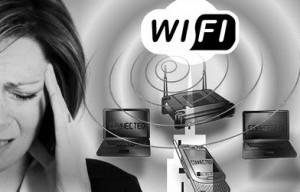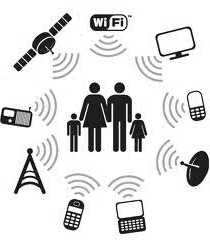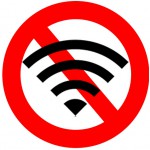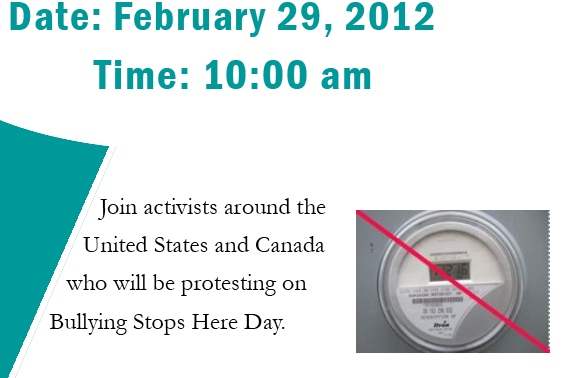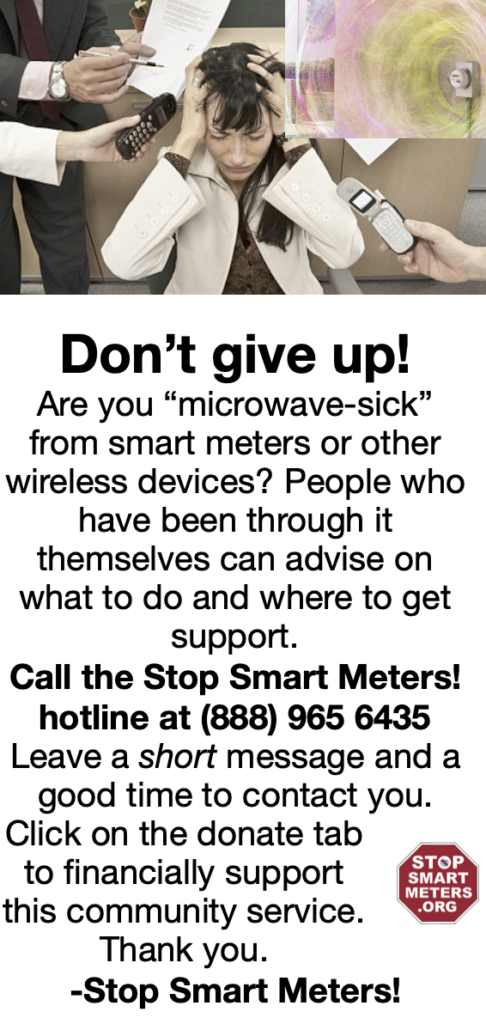by Amy O’Hair
Why does your utility assert the smart meters they are installing are safe? In a sentence, they are protected by the very high limits the FCC has set for public exposure to radio-frequency (RF) radiation.
 The RF from smart meters doesn’t exceed those limits, they say, therefore you can’t be harmed by it. Leaving aside the fact that smart meter RF pulses may in fact exceed those limits, let’s look at the FCC “guidelines.” What follows may surprise even those who think they understand the matter….
The RF from smart meters doesn’t exceed those limits, they say, therefore you can’t be harmed by it. Leaving aside the fact that smart meter RF pulses may in fact exceed those limits, let’s look at the FCC “guidelines.” What follows may surprise even those who think they understand the matter….
Who is the FCC? What do they do?
The United States Federal Communications Commission (FCC) was  never supposed to look after your health; it’s just not their job. They oversee allotting broadcast frequencies across the spectrum; mediate competition between service providers; keep communications up in emergencies; and slap the wrists of celebrities who curse on radio or peel off clothes on TV. The type of oversight they can exercise on “health” matters would be, for example, regulating the frequency of this human-implantable medical-records radio chip. Whether that chip will produce disease at the insertion site is none of their concern.
never supposed to look after your health; it’s just not their job. They oversee allotting broadcast frequencies across the spectrum; mediate competition between service providers; keep communications up in emergencies; and slap the wrists of celebrities who curse on radio or peel off clothes on TV. The type of oversight they can exercise on “health” matters would be, for example, regulating the frequency of this human-implantable medical-records radio chip. Whether that chip will produce disease at the insertion site is none of their concern.
Nonetheless, this is the government agency that has set the upper limit for how much radio-frequency (RF) radiation you can be exposed to from radio transmitters. How and when did they arrive at their “guidelines,” and what are those limits? The science is old, and the limits are sky-high.
How did we get here?
The history is a long and sordid one, beginning with the military’s 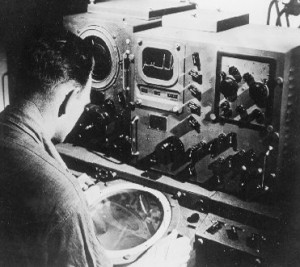 increasing use of radio technology, especially radar, in the 1950s. They didn’t want to kill or maim their soldiers and technicians outright, so they set out to find out what level of RF would injure them. The science that informed that assessment was anchored in the physics-based belief that unless you knocked an electron off a molecule inside a body—which is what x-rays or the radiation still streaming out of Fukushima can do—you couldn’t induce cancer or other long term harm.
increasing use of radio technology, especially radar, in the 1950s. They didn’t want to kill or maim their soldiers and technicians outright, so they set out to find out what level of RF would injure them. The science that informed that assessment was anchored in the physics-based belief that unless you knocked an electron off a molecule inside a body—which is what x-rays or the radiation still streaming out of Fukushima can do—you couldn’t induce cancer or other long term harm.
Radio-frequency radiation doesn’t have the energy to dislodge an electron, but it can heat human tissue–and do other things, as we’ll see. The military knew that heating wasn’t good, so they based the upper limit for human exposure on this threshold, called the “thermal effect.” FCC limits do protect you from being cooked by a psychopathic neighbor who wants to install an airport-grade radar transceiver on his roof aimed at your house. But, as it will be clear, this sort of guideline leaves a great deal to be desired in the realm of protecting public health from short-term “non-thermal” effects and long-term harm.
How do you measure RF?
Let’s start with the units used to measure RF fields in the environment. (Or you can skip ahead to rest of story.) When measuring radio frequency strength in terms of public exposure, you are looking for “power density”: that is how much radiating energy is hitting a surface (like your body’s surface). If you’ve read about RF, you may have seen figures like this: µW/cm². That means “micro-watts per square centimeter.” (‘Micro’ is represented by a Greek letter ‘mu’ µ and means ‘one millioneth’.)
That is to say, µW/cm² equals the number of millionths of a watt that are hitting a surface the size of a pinky fingernail. Some people use a different measurement: µW/m², microwatts per square meter, which is how many millionths of a watt are hitting a surface the size of a car rear window. (Your body surface is about 2 square meters total.)
Either unit can be used to represent a power density measurement. To compare the two units: 1 µW/cm² = 10,000 µW/m². That’s because you can fit ten thousand fingernails on a car rear window—10,000 square centimeters inside 1 square meter. Some people who are interested in small amounts of RF that can affect people use the second, smaller unit. It’s like if you were to describe how much water you drink a day, you’d say “32 ounces of water,” not “0.08 barrels of water” or “0.00125 cubic yards of water.” For sensitive measurements, use the fine-grained unit. Since biological effects have been observed down to low numbers of µW/m², that smaller unit is useful for talking about optimal human health conditions. Here’s a chart that lines up all the dozens of different units that electrical engineers use (yes, there are more). Here’s a calculator.
Power density is not the same as the power of the transmitter, but a stronger transmitter will create a larger power density. RF power density drops in intensity off the farther away you are from the transmitter, which is why, for example, people with smart meters near their beds are often the ones to complain of insomnia or waking with headaches.
 Congratulations, if you read and understood this section, you now know more about RF power density than 99.9% of the government officials who rubberstamp the wireless industry’s endless applications for more cell antennas. That’s enough on units for now–on with the story….
Congratulations, if you read and understood this section, you now know more about RF power density than 99.9% of the government officials who rubberstamp the wireless industry’s endless applications for more cell antennas. That’s enough on units for now–on with the story….
Low power is the norm for many wireless transmitters
A microwatt doesn’t seem like much, does it? But many radio-frequency transmissions, it turns out, don’t require a lot of power, depending on how far they must go before reaching a receiver. This is part of the reason  wireless communication is often a cheap way to transmit data; local transmitters can use small amounts of energy. And of course, there is no costly cable to lay. In many places now you can see wireless antennas on pole tops with no wired-in electricity, just a small solar panel for power. (Right: photo of SFPark.org antenna.) WiFi transmitters can reach hundreds of feet with just a third of a watt. Your cell phone can operate with a half- or even a quarter-watt. The older high-power cell phones used to go dead fast because they sucked a lot out of their batteries.
wireless communication is often a cheap way to transmit data; local transmitters can use small amounts of energy. And of course, there is no costly cable to lay. In many places now you can see wireless antennas on pole tops with no wired-in electricity, just a small solar panel for power. (Right: photo of SFPark.org antenna.) WiFi transmitters can reach hundreds of feet with just a third of a watt. Your cell phone can operate with a half- or even a quarter-watt. The older high-power cell phones used to go dead fast because they sucked a lot out of their batteries.
The FCC says the transmitter in a smart meter is supposed to be limited to 1 watt, but we’ve learned in the last year that the antenna pumps that up to an effective power of 2.5 watts. In addition, smart meters contain a capacitor or a battery that produces, at the moment of transmission, a burst of power. Think of flash units on cameras, which build up power in a capacitor, then release it all suddenly at the moment of the flash, making an intensely bright light, but only for a fraction of a second. We’d like to know how much power all that adds up to in the smart meter at the moment of the RF pulse, but smart meter manufacturers won’t release the specifications on their products or components.
That is not to say that wireless networks overall don’t use an enormous amount of power–they do. Cell antenna arrays can have huge power draws. But the RF transmitters which you come into close contact with every day are in general low power.
Low power RF doesn’t mean low biological effect
RF transmitters with small amounts of power have definite effects on bodies. 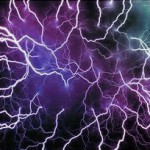 As biological organisms, we produce millions of tiny electrical signals internally—regulating our heart, our nerves, our cellular metabolism. In medicine, there are procedures that use RF with small amounts of power, to produce distinct changes in the body. This new treatment kills the malaria parasite with cellphone-strength RF (less than 1 watt), while the researchers blithely state that it shouldn’t be used for the head or torso area. This treatment for liver cancer uses low-power RF targeted to kill the tumor cells.
As biological organisms, we produce millions of tiny electrical signals internally—regulating our heart, our nerves, our cellular metabolism. In medicine, there are procedures that use RF with small amounts of power, to produce distinct changes in the body. This new treatment kills the malaria parasite with cellphone-strength RF (less than 1 watt), while the researchers blithely state that it shouldn’t be used for the head or torso area. This treatment for liver cancer uses low-power RF targeted to kill the tumor cells.
How could the FCC—whether or not they have doctors on staff (they don’t)—approve the RF used in medical devices, and then not wonder about what is happening in the bodies of the untold numbers of people being exposed to fields that are several thousand times stronger? They don’t wonder; it’s not their job.
Low power is enough power! Enough to: Damage the fetal brain. Make cells leaky. Adversely affect the heart rhythm. Damage sperm. Break DNA. Damage DNA. Increase glucose in the brain. Cut immunity. Dull memory. Stress genes. Worsen allergies. Weakened bones. More.
The FCC limits are a terrible joke
So, what are those sky-high limits on RF that the FCC has set? At the cell-phone and smart-meter range of frequencies, the FCC says that a field with an average power density of about 600 µW/cm² (6,000,000 µW/m²) is okay for humans for 30 minutes. Above that, your tissues begin to heat up, something everyone agrees isn’t good.
That’s average power density. I’m not sure I can emphasize this point enough: inside that 30 minutes, there could be a great number of peaks at much higher levels—just as long as the average reading comes out below that stipulated limit.
Time-averaging RF erases peak spikes
With modern technologies which can produce a transmission pattern of millisecond pulses–and all smart meters and cell phones do this–a device can emit pulses which at their peak far, far exceed the FCC upper limit, yet when averaged will appear to comply with it, even be far below it. One EMF technician associated with Stop Smart Meters! during his preliminary data gathering has recorded a peak pulse in excess of 20,000 µW/cm² (=200W/m²) and observed ones far higher than this.
Time-averaging is how PG&E hides the true peak levels of RF pulses produced by their smart meters. This chart below shows the stark difference between averaged (red) and actual (blue) RF levels measured from a similar smart meter in southern California (chart courtesy EMF&RF Solutions, www.EMFRF.com).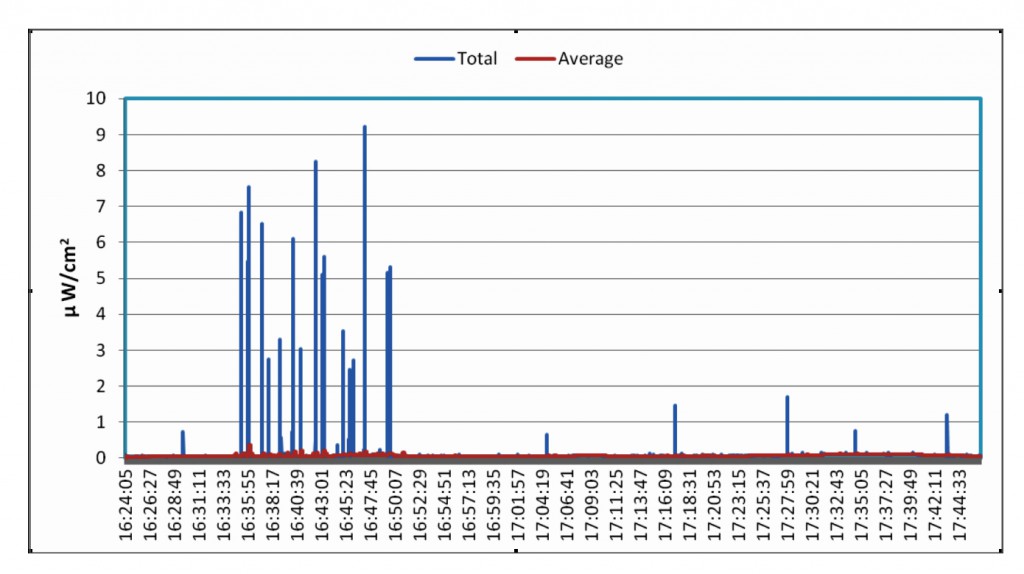 I checked in with an associate who has a PhD in electrical engineering: how many high peaks could you have, and end up with a low average? We invented an example and calculated the average level using information from the FCC’s own document addressing the matter. A thirty-minute period could contain one hundred (100) 5-millisecond pulses (at 900MHz) (duty cycle=0.02%), each pulse a whopping 100,000 µW/cm² each (the big unit), and the averaged level could be calculated to be around 28 µW/cm². The device’s maker could then claim this constituted only about “5% of FCC limits.” But a person standing in that field would actually be subjected to very high bursts of RF energy, which have been shown to have biological effects.
I checked in with an associate who has a PhD in electrical engineering: how many high peaks could you have, and end up with a low average? We invented an example and calculated the average level using information from the FCC’s own document addressing the matter. A thirty-minute period could contain one hundred (100) 5-millisecond pulses (at 900MHz) (duty cycle=0.02%), each pulse a whopping 100,000 µW/cm² each (the big unit), and the averaged level could be calculated to be around 28 µW/cm². The device’s maker could then claim this constituted only about “5% of FCC limits.” But a person standing in that field would actually be subjected to very high bursts of RF energy, which have been shown to have biological effects.
This engineer then set out to find what the maximum allowable peak pulse is, according to FCC standards, and particular, what power density would a smart meter pulse be permitted to peak at? Although there is a reference to a “guideline” of 4,000µW/cm² as determined by ANSI/IEEE C95.1-1992 in the Sage Report discussion on peak power limits, we couldn’t find explicit limits stated anywhere else. Here is a recognized dangerous substance, and there is effectually NO regulation on the upper limit of peak pulses the public is exposed to.
 Are you an electrical engineer who can tell us what that upper limit on the peak pulse of a PG&E smart meter is? What is allowable? Calculated? Measured? We want to know. Write info@StopSmartMeters.org, and if you can back up your claim, Stop Smart Meters! will consider a guest post where you can tell readers what you know.
Are you an electrical engineer who can tell us what that upper limit on the peak pulse of a PG&E smart meter is? What is allowable? Calculated? Measured? We want to know. Write info@StopSmartMeters.org, and if you can back up your claim, Stop Smart Meters! will consider a guest post where you can tell readers what you know.
The time-averaging issue shows up an important point: patterns of exposure—like these sharp spikes—are not part of the FCC’s considerations concerning the effects of RF on humans. This is a serious oversight, and any revision of the FCC guidelines should address this as well.
The best analogy to these spikes of RF energy is a strobe light. Using the same energy as a low-watt bulb, a strobe light produces very intense millisecond pulses of light, several per second, and has been shown to adversely affect the brain, inducing seizures in some people. RF is an electromagnetic energy like light, but one that penetrates into the surface of our bodies. (This paper by Karl Maret, MD, has excellent references on pulsed RF effects on humans.)
Many observers trying to reckon with the sheer number and consistency of smart-meter health complaints have seriously wondered whether this particular under-regulated and unaccounted-for factor might be at the heart of the harm done by wireless utility meters.
Many questions are utterly unaddressed by FCC guidelines
Smart-meter pulses aside for a moment, there are many other exposure issues that lay outside the FCC guidelines. Why isn’t there an effective limit on the maximum peak level? How much time should pass between 30-minute stints at that high level?
 How much total RF are we getting from all the various RF sources in our lives? What about the vulnerable among us? Pregnant women? Children?
How much total RF are we getting from all the various RF sources in our lives? What about the vulnerable among us? Pregnant women? Children?
What is the biological effect of a low dose over a long period? Over a lifetime? This is a much better description of the modern public exposure pattern than the brief exposures that radar technicians of the 1950s had to contend with.
I admit it is very unlikely that the FCC will address these kinds of questions in the near future. Nor are they passing the matter to any other agency which might have authority regarding public health, such as the FDA or the EPA. Formulation of the original standards could not possibly have foreseen how the vast majority of non-military citizens would end up spending all day, or nearly all day, in a substantial RF field.
RF exposures have changed radically; the guidelines have not
There has been no review of the matter at the FCC despite massive changes in technology and consumer behavior. Established in the 1970s based on 1950s science, and firmed up in the Telecommunications Act (TCA) of 1996, (just as cellular networks were going up), the guidelines have not been reviewed since then—even as usage patterns have changed drastically. For example, for purposes of the Interphone Study (2004)–which despite massive flaws is often cited by those who dismiss cell-phone cancer risk–a “regular user” was someone who used a cell phone at least once a week. Today many users are on their phones two or three hours a day, equaling 800 – 1200 minutes a week—while also being exposed to numerous other RF sources in the environment, like WiFi, cordless phones, antennas, GPS devices, and smart meters. Smartphones produce nearly constant personal exposures for users via automated network connections.
Has the FCC followed up, as remarkable technological changes have resulted in substantial increases in personal RF exposure? No. They haven’t  re-considered the matter in decades. Basic field data is largely untracked. They only measure RF emissions at a tiny fraction of wireless installations—they don’t have the staff to investigate. The same goes for the RF levels you get in your own home from consumer devices like cordless phones. Additionally, it is the EPA who is supposed to regularly assess overall pollution levels in the environment, but they haven’t touched RF for four decades since an assessment in 1979.
re-considered the matter in decades. Basic field data is largely untracked. They only measure RF emissions at a tiny fraction of wireless installations—they don’t have the staff to investigate. The same goes for the RF levels you get in your own home from consumer devices like cordless phones. Additionally, it is the EPA who is supposed to regularly assess overall pollution levels in the environment, but they haven’t touched RF for four decades since an assessment in 1979.
Some who support wireless proliferation say RF transmitters have been with us since the first days of radio, when a few high-power transmitters dotted the country. But this misses the vital point: at no point in the past have so many people had multiple RF and microwave transmitters so close to their bodies–right next to their heads, in most cases; there is no science to assure the safety of such close, long-term contact.
Last year in May 2011, the IARC, part of the World Health Organization, finally decided, after years of wrangling, that RF radiation can possibly cause cancer (Class 2B). This decision was arrived at even though many of their members have heavy-duty wireless industry ties and have not been known for precautionary vigilance in protection of public health.
Did this new—though conservative—designation provoke the FCC to review its guidelines? No. You won’t find any changes made in their safety guidelines in light of this landmark. There is nothing on the FCC website regarding this important announcement.
Why aren’t these FCC limits sufficient to protect us from harm?
RF effects that fall below that FCC limit are called “non-thermal.” But it turns out “non-thermal” does not mean harmless, it just means not cooking you. Many things happen to your cellular metabolism, cardiac system, and neurological system, before you get up to the heating point. (See above for more info.)
 One of the more disturbing effects is a marked increase in permeability in the blood-brain barrier (BBB). (Here is another study.) This vital cellular gatekeeper protects your precious and otherwise vulnerable neocortex from being flooded with the various microscopic gunk you breathe and eat and touch everyday. Do I need to mention how important your brain is?
One of the more disturbing effects is a marked increase in permeability in the blood-brain barrier (BBB). (Here is another study.) This vital cellular gatekeeper protects your precious and otherwise vulnerable neocortex from being flooded with the various microscopic gunk you breathe and eat and touch everyday. Do I need to mention how important your brain is?
RF has other effects on us, and cancer is among them. Admittedly no one wants cancer—but it may be that in the long run, a million people with chronic ill health over several bodily systems may be a more serious public-health problem than a hundred people with cancer. So searching for definitive cancer effects from RF (though evidence for that is clear) may actually be distracting regulators from reckoning with the larger picture: every person in modern society—from conception onward—is exposed to unprecedented levels of RF, and that may represent the true burden of disease, which leaves cancer as the mere iceberg-tip.
What is a biologically based RF limit for humans?
Who else besides the FCC has addressed the matter of how much RF is all right for humans? Some scientists have approached the matter by asking how much RF radiation it takes to produce adverse effects in humans. Using observed biological effects–in the test tube and in animals–as well as taking into account what happens in populations of humans who are exposed to things like cell antennas, they have arrived at very different conclusions about how much we should be exposed to.
How different is a biologically based RF limit from the FCC limit? About ten thousand times different. That’s about the size of the spread between the FCC “guidelines” and the level that scientists tracking the actual effects on biological life recommend for human exposure. Example: The Bioinitiative Report recommends 0.1 µW/cm² (big unit) for an outdoor maximum. (See links below for other biologically based guidelines.) To repeat: FCC limit: 600 to 1000 µW/cm² vs Bioinitiative: 0.1 µW/cm². Realistically speaking, this massive gap isn’t one that can be bridged in the near future. The wireless industry has their back covered by these government regulations, leaving the public uninformed and unprotected.
But cracks are showing. Last year San Francisco passed a cell phone right-to-know 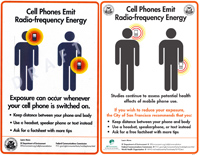 ordinance—but it was promptly silenced by a lawsuit from the Cellular Telecommunications Industry (CTIA), then shot down by a federal judge who compared it to warning people about UFOs. However, there is slow progress. Last week, the Israeli Knesset passed a law requiring labels on all cell phones warning users about cancer, and the vulnerability of children.
ordinance—but it was promptly silenced by a lawsuit from the Cellular Telecommunications Industry (CTIA), then shot down by a federal judge who compared it to warning people about UFOs. However, there is slow progress. Last week, the Israeli Knesset passed a law requiring labels on all cell phones warning users about cancer, and the vulnerability of children.
But the stakes are high for maintaining RF limits where they are now—unprotective, unreviewed, barely enforced, and sky-high. There are now more cell-phone accounts in the U.S. than actual citizens. The proceeds–$165Billion in the US in 2011–are immense profits for the industry players. On one hand, the bottomless coffers of the wireless industry assure them of compliance from politicians who are ever in need of money, and on the other hand, the industry gets little pushback from the general public, who are largely distracted and entranced with consumer techno-gizmos.
Under federal law, your city cannot prohibit antennas on the grounds of health or environmental damage
Complicating the matter of regulation is the fact that, by law, no U.S. city, county, or state can object to any telecommunications facility (e.g. cell antenna) on the grounds of real or perceived health damage. If this is news to you, I am sorry. I was shocked myself to find this out. This was written into the Telecommunications Act (TCA) of 1996, § 704, signed into law by President Clinton, and remains the law of the land. Here’s a summary about the issue from the FCC. Here’s some legal analysis from a law review. And here’s some commentary from B. Blake Levitt, “The Struggle for Local Control.”
Every elected or appointed local public representative is thus prevented from acting to protect public health. But the public can–and should–still speak out against public harm from wireless facilities.
So you can be made sick, or sleepless, or get cancer, from your local cell phone tower, and there is nothing, as of now, you can do to legally stop it or get compensation for your injury. You can’t sue the industry, and you can’t sue your city, state, or federal government, at least not on the grounds of disease. This particular clause is an outright theft of local governmental power to protect constituents, and must be overturned.
Perhaps here too, there are changes mounting. This week Greenwich CT pushed back on the siting of cell towers near concentrations of children, while explicitly citing health concerns as the rationale.
What can we do?
Government regulation is a long way behind the science, and even further behind the so-called “precautionary principle”—the basic notion of protecting people from a pollutant until safe levels have been assessed. The clause quashing objections on health grounds in the TCA (above) leads this citizen to wonder whether the harm to the public from wireless installations was actually fully anticipated by our government and the big-business interests who pushed the bill through in the 1990s. Why else would they have essentially muzzled any effective objections by people or communities trying to protect their health and life? (You are allowed to object on the grounds of ugliness, but now the industry is going to great pains to hide antennas and make them disappear visually.)
Invisible and silent, RF can be scary to contemplate because it can’t be sensed by most people. Millions use a cell phone all day with no way to assess their total exposure, or sit next to a cordless phone base or WiFi unit without even being aware that it is a constant source of high levels of pulsed RF.
The current mass addiction to smartphone connectivity has been compared to cigarette smoking. But even in the heyday of cigarettes, 25% of people refused to smoke—perhaps because there was always immediate sensory feedback about it—the hot stinky smoke, eyes stinging, coughs, bad breath. Anyone can smell smoke, but very few people can sense RF or its effects right away.
Having a device to measure RF is the only way for most people to know quickly that they are in the presence of RF, and how much. But it’s tedious and somewhat antisocial to always be whipping out a little meter to find out how much pollution is in the air around you (having done it for a while now myself).
But that doesn’t leave you helpless. Even without a measuring device, there are still very clear things you can do to cut your personal exposure:
- Ditch the cordless phone and get a wired landline;
- Cut your total cell-phone use and configure your phone to avoid automated connections;
- Disable your WiFi unit and wire your internet connection;
- And, of course, refuse to allow smart meters on your home or in your neighborhood.
Changing your exposure to these four devices can make a big difference in your total exposure; better sleep can be an immediate benefit for some. However, for electro-sensitive people, these measures are often insufficient, and a normal life is very difficult.
Radio-frequency radiation is a matter of public health
Individual precautions are not enough, because the very nature of RF is that it penetrates bodies and structures—ultimately, it doesn’t respect your “personal choices.” One person’s actions are not enough to address the issue for EMF-sensitive persons who suffer with very low exposures, and for the vulnerable among us like children, pregnant women, and the aged. We’ve documented how even those working in high tech can become sensitized over time. Poorly regulated RF has public health consequences.
The lack of meaningful regulation means you may not have any way to avoid the RF radiation you are exposed to at work, or from your local cell phone antenna or your neighbors’ smart meters, or on public transportation. There are numerous situations where RF exposure is in no way a matter of “personal choice.”
“Personal choice” in consumer devices has lead to massive involuntary public exposure from ever-proliferating antenna arrays near homes, schools, and public places–like the DAS antennas currently going up in residential neighborhoods. Mouthing off about “personal choice” has been the devious way that PG&E and other utilities have avoided facing up to the effects their meters have on whole communities, the general public, and those exposed to large banks of smart meters.
While one can choose personal self-protection, it is simply not enough.
The FCC guidelines for radio-frequency emissions must be changed to protect the public from both harmful incidental exposures and personal consumer-device exposures.
There are people working to institute a review of these outdated guidelines. There are petitions and blogs. There are excellent groups working for cell-phone warnings and public awareness. There are even people like me roaming around measuring RF in their communities and talking to strangers. There isn’t one single answer.
Please read the links below and consider some actions. First and foremost, help yourself or someone you love learn how to avoid unnecessary RF exposure. Talk to people you know–most people have no idea there is even an issue, so this is a powerful way to change awareness. Write a letter or email to your legislator. Become a member of a coalition fighting for public awareness. Show up and speak at a public hearing on siting cell antennas. Don’t just sit there and get dosed.
[PDF of this article now available here.]
_____________________________________________________
Amy O’Hair has been researching and measuring smart meters and RF for the past year, and posting videos here: youtube.com/ThisIrradiatedLife. Twitter: @vegosapien
_____________________________________________________
LINKS (also check “external links” in our top menu):
Groups and individuals working for RF awareness and better regulation:
Summaries, accounts, and overviews of EMF/RF regulation:
Biologically based standards, proposals, and organizations:
Find your Legislator in CA. http://www.leginfo.ca.gov/yourleg.html
Cell phones and health damage:
Personal shielding and protection:
Find the cell antennas near you: http://www.antennasearch.com/
















